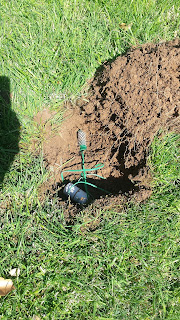Today I finally got around to installing my moisture sensors in the lawn. I'm using the one-wire moisture reader from
http://www.hobby-boards.com/store/ (who, btw, are sadly going out of business and fire-selling all the inventory, so if you want one, buy it now.
It uses the probes from a Davis moisture meter. I think they were about $75 each, so a bit pricey! Sadly, I purchased the setup about 2 years ago, but have kept putting it off, because, well, digging a trench sucks.
However, the trench is done, and the probes are installed. Luckily, literally 5 minutes before the lawn guys showed up to mow.
A long time ago, I buried a length of direct burial wire right up to the edge of the lawn. After playing forgetful pirate for a few hours, I located the buried bundle, and pulled it all out. I needed a way to connect the sensors to this Cat6 that wouldn't end up with water inside the sensor. I think I came up with a good way, we will find out over time.
 |
| The wires, all hooked up. |
|
|
For each one, I stripped the middle of the wire, hooked the sensor up to the chosen pair, and then jammed it through a hole I drilled in a 3/4" PVC end cap. I then filled the little chunk of PVC with silicone, let it dry, and then installed the other cap. Hopefully this will keep the sensor connections dry. I also did use shrink wrap on them, so it should be fine.
I was also apparently smart enough to bury an extra wire, so I used this to hook up a DS18B20 temperature sensor too. I did essentially the same thing for that one, except this time,I put a huge glob of silicone all inside the hole, and pushed the sensor through that hole, so it would be close to the outside, without actually touching any water.
Finally, each sensor was buried in the ground in it's final resting place. I was able to find the manual online for the sensors, and it suggested a 45' angle, 3-5" deep for turf. So that's what I did. Rather than digging a full trench, I just used a shovel to make a slit in the ground, and then found some random tool and shoved the wire down into the slit. Basically, it just needs to be deep enough so a mower doesn't eat it. They said to install the sensors soaking wet, so right now, I'm not getting any useful data from them. Well, the ground temp sensor is reading 61F, and it's about 70F out right now, so that's something I guess.
As part of the prep for installing the sensors, you are supposed to soak them for 30 minutes, and let them dry for 12 hours, over and over. While doing this, I noticed they dry out very slowly. They were not quite fully dry by morning, maybe half way. So they probably respond rather slowly.
Also, in what was a bit of a surprise to me, they read in cb, or centibars, which is a unit of pressure. Basically they tell you how much pressure (like suction on a straw) is required to remove moisture from the surrounding soil, into the sensor. I guess this simulates roots drawing water in, and how difficult or easy it is. Bone dry, a sensor reads 199cb. Soaking wet, 0cb.
Once I have some accumulated data, I'll post pretty graph pics.








